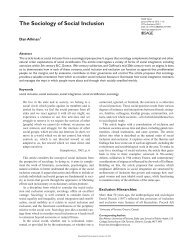Inclusive Education for Learners With Disabilities in ... - SAGE Open
Inclusive Education for Learners With Disabilities in ... - SAGE Open
Inclusive Education for Learners With Disabilities in ... - SAGE Open
Create successful ePaper yourself
Turn your PDF publications into a flip-book with our unique Google optimized e-Paper software.
8 <strong>SAGE</strong> <strong>Open</strong>education. Teachers <strong>in</strong> this study expressed the need <strong>for</strong>reduced class sizes, more resources, and additional supportservices. As most teachers did not receive any special educationtra<strong>in</strong><strong>in</strong>g <strong>in</strong> their university studies, they feel that theyare not qualified to implement the <strong>in</strong>clusion processes.Despite positive peer acceptance, this study revealed thatregular classrooms <strong>in</strong> Botswana failed to support the learn<strong>in</strong>gneeds of all the learners with disabilities. It could beconcluded that placement <strong>in</strong> <strong>in</strong>clusive classrooms is notenough; it is important to make sure that learners with disabilitiesreceive all the necessary support and services <strong>for</strong>access<strong>in</strong>g the curriculum and cocurricular facilities. Thef<strong>in</strong>d<strong>in</strong>gs of this study confirm the view that implement<strong>in</strong>g<strong>in</strong>clusive education is challeng<strong>in</strong>g. Although the results ofthis study focused on Botswana, the suggestions may beuseful <strong>for</strong> other develop<strong>in</strong>g countries.Specialized Tra<strong>in</strong><strong>in</strong>g FacilitiesThe Department of Teachers Tra<strong>in</strong><strong>in</strong>g and Development <strong>in</strong>collaboration with regional <strong>in</strong>-service officers should organizecont<strong>in</strong>uous professional development opportunities on<strong>in</strong>clusion strategies of learners with special needs. However,it is important to note that <strong>in</strong>-service tra<strong>in</strong><strong>in</strong>g programsalone rarely result <strong>in</strong> teacher behavior change (Kaikkonen,2010). What is needed are multiple components of professionaldevelopment that <strong>in</strong>clude tra<strong>in</strong><strong>in</strong>g, implementationguides, classroom materials, <strong>in</strong>structional coach<strong>in</strong>g, andper<strong>for</strong>mance feedback <strong>for</strong> teachers (Fox, Hemmeter, Snyder,B<strong>in</strong>der, & Clarke, 2011). In addition, these workshopsshould equip teachers with practical skills on <strong>in</strong>struction,collaboration, alternative <strong>for</strong>ms of evaluation, classroommanagement, and conflict resolution, and on how to adaptthe curriculum. At the same time, the teachers’ <strong>in</strong>itial tra<strong>in</strong><strong>in</strong>gprograms should <strong>in</strong>corporate <strong>in</strong>clusive education components(Forl<strong>in</strong>, 2010).ResourcesProvisions of human and material resources are also important<strong>for</strong> implementation of <strong>in</strong>clusive education. TheDepartment of Curriculum Development and Evaluationshould provide more adequate resources, equipment, andteach<strong>in</strong>g material <strong>for</strong> learners with diverse learn<strong>in</strong>g needs.The number of resource centers <strong>in</strong> Botswana should be<strong>in</strong>creased, and they should provide advice to parents, educators,and others who are <strong>in</strong> need of <strong>in</strong><strong>for</strong>mation about regulations,evaluation, and support services <strong>for</strong> children withdisabilities. Some of the special schools or special units maybe upgraded to resource centers.Special <strong>Education</strong> TeachersAlthough M<strong>in</strong>istry of <strong>Education</strong> and Skills Development(MoESD) have recruited STALDs to support learners withdisabilities <strong>in</strong> every school, the majority of STALDs are nottra<strong>in</strong>ed <strong>in</strong> the area of special education. There<strong>for</strong>e, theseteachers are fail<strong>in</strong>g to support teachers and learners adequately.MoESD should recruit tra<strong>in</strong>ed STALDs, and thosewho are not tra<strong>in</strong>ed should be tra<strong>in</strong>ed through <strong>in</strong>-servicetra<strong>in</strong><strong>in</strong>g. Teach<strong>in</strong>g Service Management and the Departmentof Support Services of MoESD should come up with clearjob descriptions of STALDs to work effectively <strong>in</strong> <strong>in</strong>clusiveclassrooms.TeamworkIt appears from this study that there is a lack of coord<strong>in</strong>ationamong teachers, special educators, parents, and professionals.Stakeholders should be encouraged to participate <strong>in</strong> theimplementation of <strong>in</strong>clusive education. Parent TeacherAssociations might play a pivotal role <strong>in</strong> strengthen<strong>in</strong>g theteamwork.AcknowledgmentsThe authors wish to thank reviewers <strong>for</strong> valuable comments onearlier versions of this article, and Professor John Riser <strong>for</strong> review<strong>in</strong>gand revis<strong>in</strong>g the f<strong>in</strong>al manuscript. They would also like to thankthe participants <strong>for</strong> contribut<strong>in</strong>g their valuable time dur<strong>in</strong>g datacollection.Declaration of Conflict<strong>in</strong>g InterestsThe author(s) declared no potential conflicts of <strong>in</strong>terest withrespect to the research, authorship, and/or publication of thisarticle.Fund<strong>in</strong>gThe author(s) received no f<strong>in</strong>ancial support <strong>for</strong> the research and/orauthorship of this article.ReferencesAlur, M. (2002). “They did not figure”: Policy exclusion of disabledpeople <strong>in</strong> India. International Journal of <strong>Inclusive</strong> <strong>Education</strong>, 6,101-112.Atk<strong>in</strong>son, P., & Coffey, A. (2002). Revisit<strong>in</strong>g the relationshipbetween participant observations and <strong>in</strong>terview<strong>in</strong>g. In J. F.Gubrium & J. A. Holste<strong>in</strong> (Eds.), Handbook of <strong>in</strong>terviewresearch (pp. 801-814). Thousand Oaks, CA: <strong>SAGE</strong>.Brandon, D. P. (2006). Botswana’s family and consumer sciencesteachers’ attitude towards the <strong>in</strong>clusion of students with physicaldisabilities. Journal of Family and Consumer Sciences <strong>Education</strong>,24(1), 37-49.Brownell, M., & Pajares, F. (1999). Teacher efficacy and perceivedsuccess <strong>in</strong> ma<strong>in</strong>stream<strong>in</strong>g students with learn<strong>in</strong>g and behaviouralproblems. Teacher <strong>Education</strong> and Special <strong>Education</strong>, 22,154-164.Creswell, J. W. (1998). Qualitative <strong>in</strong>quiry and research design:Choos<strong>in</strong>g among five traditions. Thousand Oaks, CA:<strong>SAGE</strong>.deBettencourt, L. (1999). General educators’ attitudes towardsstudents with mild disabilities and their use of <strong>in</strong>structionalstrategies. Remedial and Special <strong>Education</strong>, 20, 27-35.Downloaded from by guest on January 12, 2015















